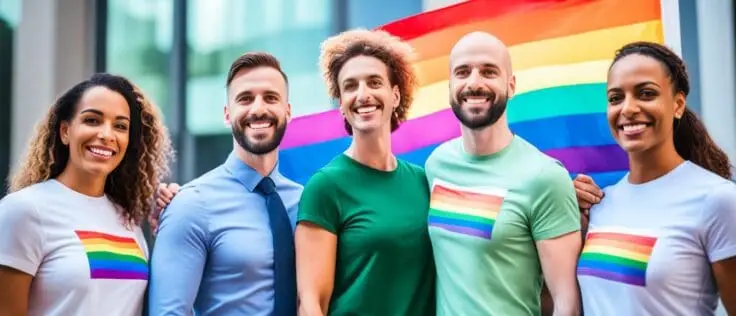How can businesses truly thrive if a significant portion of their workforce remains invisible?
Having role models like Samira Wiley and Lynn Gunn is empowering. They give strength and courage to people to be themselves. However, in the business world, LGBTQ+ visibility is still rare. This lack shows that there is not enough queer representation in professional roles. In the UK, laws protect LGBTQ+ people at work since 2003. The Equality Act of 2007 and 2010 also helped, covering sexual orientation and gender reassignment. But, challenges still exist. Up to 60% of UK graduates hide their LGBTQ+ identity when they start working. This shows a strong culture of heteronormativity. It highlights the need for a big change in business culture.
Even with legal progress, less than 5.1% of corporate America’s leaders are LGBTQ+ women. At entry-level jobs, this number falls to 2.3% and then to 1.6% at management levels. There’s clearly a big gap in including LGBTQ+ people and achieving equality at work. LGBTQ+ women often feel they are the “only” ones at their workplace. They face many microaggressions that affect their career growth.
Still, there’s some progress. A record 206 major corporations have supported the Supreme Court’s decision to protect LGBTQ+ workers from discrimination. This shows efforts towards diversity in business. But, the ongoing struggles show the need for more work. We need to see more queer professionals. This will create a work environment that is inclusive and fair for everyone.
Understanding LGBTQ+ Representation in the Workplace
The LGBTQ+ workforce still experiences a gap in many workplaces, despite big legal steps forward. It’s quite telling that 206 large companies supported the Supreme Court’s June 2020 decision. This decision was to protect LGBTQ+ people at work. However, we don’t yet see enough LGBTQ+ people in these workplaces.
A study by UM shows that almost half of young people, aged 18 to 25, don’t see themselves as 100% straight. But, this openness isn’t reflected in company roles, lagging far behind society. The challenge is to challenge the outdated norms and toxic behaviors that are still too common in offices.
Only a small fraction of US women and men identify as LGBTQ+, but even fewer are in the early stages of their careers or in management. This gap shows a big issue with diversity in the workplace. Also, it’s troubling that bisexual women face more negativity than their peers.
More than half of LGBTQ+ women have dealt with sexual harassment at work, a much higher rate than their straight colleagues. The fear of being overlooked for promotions because of who they are concerns 15% of LGBTQ+ women. This fear forces many to hide their true selves, adding to their stress at work.
Trans workers face tougher challenges. They often feel alone as the only one representing their gender or sexual orientation at work. Compared to their cisgender peers, they’re less likely to be in leadership roles. This isolation highlights why workplaces must better support gender diversity.
It’s vital for companies to create spaces where everyone feels safe and welcomed. Despite legal protections, the struggles of the LGBTQ+ workforce show we need more action. Continued efforts are necessary to improve workplace diversity and policies against discrimination.
The Benefits of LGBTQ+ Visibility for Businesses
Allowing different identities in businesses is crucial and beneficial. It builds a place where employees feel they belong, fostering acceptance. A supportive environment reduces anxiety and depression in LGBTQ+ employees. This shows how vital an inclusive corporate culture is.
Companies that support LGBTQ+ inclusion see a boost in productivity. Diverse teams introduce new ideas, improving innovation and communication. As Mike Robbins points out, being able to be oneself at work increases performance.
LGBTQ+ visibility shows a company’s dedication to diversity, attracting top talent. Employees stick with companies that make them feel appreciated. According to S&P Global CSA 2021, many companies see diversity as key. But, they still need to be more open about LGBTQ+ employees.
An inclusive culture betters employee happiness and team spirit. Companies can show their support by joining PRIDE events and helping LGBTQ+ charities. This way, leaders create a welcoming space for all, leading to a fairer future.
Challenges Faced by LGBTQ+ Employees in the Workplace
LGBTQ+ workers in the UK still face discrimination, despite progress towards more inclusive workplaces. They deal with issues ranging from broad corporate challenges to daily slights. For example, over half of LGBTQ+ women have faced sexual harassment at work. This is higher than the rates for straight women and LGBTQ+ men.

LGBTQ+ women are less likely to move up in their careers compared to their straight peers. They represent 2.3 percent of new hires but only 1.6 percent of managers. Many feel alone, being the “only” LGBTQ+ person in their environment. They face more pressure to show they’re good enough, making it harder for them to succeed.
Bisexual women experience more subtle discrimination than others. They face more challenges than their straight or LGBTQ+ male colleagues. Additionally, a significant number of LGBTQ+ workers worry their sexual orientation will limit their career growth. This fear is more common among LGBTQ+ men than women.
Many LGBTQ+ employees hide their identity at work. 26% don’t tell their co-workers, and 50% keep it from their bosses. This makes it hard for them to feel part of the team. In the US, about 1.4 million transgender adults face even tougher challenges. They often get stuck in entry-level jobs and can’t be themselves at work.
The Role of Business Leadership in Promoting LGBTQ+ Visibility
Business leaders play a vital role in enhancing LGBTQ+ visibility. They need to create a culture where everyone feels welcome. This includes promoting diversity and supporting queer rights in business. Actions like public support from top management and sharing their own stories can help.
Such measures boost connection and keep talented LGBTQ+ people. Yet, 40% of LGBTQ+ staff hide their identity at work. Businesses must improve to attract this diverse and vibrant talent pool.
Research shows young straight employees often form strong bonds with LGBTQ+ co-workers. They are also keen on supporting ally programs. This trend underlines the importance of proactive diversity promotion by leaders.
Leaders like Alan Joyce and Inga Beale stand up for LGBTQ+ rights. Their commitment encourages a more accepting work environment. By fighting stereotypes, they boost job satisfaction and shape a welcoming business world.
Successful Case Studies of LGBTQ+ Visibility in UK Businesses
In recent years, UK companies have made great progress in diversity and equity at work. PRMA Consulting is a prime example of LGBTQ+ initiatives enhancing employee experiences. They show how celebrating diversity greatly benefits everyone in the company.
They’ve started strong employee network groups for LGBTQ+ staff. These groups are vital for sharing experiences and offering support. They help break down barriers, allowing for free self-expression.
Visibility of role models in the company is another success factor. Seeing successful colleagues who are like them boosts employees’ confidence. PRMA Consulting, among others, has understood the importance of role models. This helps dismantle stereotypes and build an inclusive culture.
Comprehensive training on LGBTQ+ issues is also crucial. It educates staff and reduces discrimination. Last year, 35% of LGBTQ+ employees hid their identity due to fear of bias. Also, 18% faced negative behaviour. Yet, with these initiatives, 76% now feel accepted at work.
Success stories like PRMA Consulting’s showcase the strong impact of inclusivity on LGBTQ+ visibility. By focusing on inclusivity and diversity, companies become more welcoming. This approach also boosts innovation and productivity in their teams.
The Importance of Visible Role Models
Visible role models are key in boosting confidence and proving success is possible without hiding who you are. They are especially crucial for LGBTQ+ visibility, where public figures help shape social attitudes. They provide inspiration and show that being different is okay.

The numbers show big differences in leadership roles based on gender. For example, less than 7% of global leaders are women, and only 4% of Fortune 500 CEOs are female. Visible role models are vital for all groups facing marginalisation. In Indian villages, female leaders have inspired young girls to dream bigger, shrinking the education goal gap by 25%.
Research has tracked the impact of representation for years. Initially, nearly no students drew women as scientists. But by 2018, 24% did. This change shows the strong impact that female scientists’ visibility has had over decades.
When athletes and activists are open about their LGBTQ+ identities, it changes societal standards. Their visibility encourages others and shows the power of embracing who you are. By being visible, these figures not only help future generations but also make society more welcoming for everyone.
Strategies for Enhancing LGBTQ+ Visibility in the Workplace
Making the workplace inclusive for everyone includes embracing diverse strategies. This is vital for LGBTQ+ visibility. Adopting these steps helps create a welcoming environment for all. Prioritising inclusive development is also key for businesses looking to support LGBTQ+ employees.
When the workplace supports LGBTQ+ inclusivity, everyone feels less stressed. This makes employees happier and more productive. Setting up support networks and LGBTQ+ groups can build a supportive atmosphere. It encourages everyone to share their stories, promoting openness.
Hosting workshops and joining programmes like Stonewall’s “LGBTQ+ Workplace Role Models” encourage being great role models. Visible role models in a company make everyone feel valued, breaking down social barriers. They show how important inclusivity is and encourage others to do the same.
Companies committed to LGBTQ+ rights tend to attract a diverse workforce. This leads to higher staff retention. Such workplaces often see better financial growth and innovation. This is because diverse teams perform better than those that aren’t.
LGBTQ+ employees add varied perspectives, improving problem-solving and communication. A successful workplace benefits from this diversity. It’s important to offer LGBTQ+ benefits, use inclusive language, and provide inclusion training.
Working on LGBTQ+ visibility shows employees they are valued and belong. It allows for open self-expression without the burden of hiding true identities. Creating this sense of community is crucial for everyone’s well-being.
The Impact of LGBTQ+ Visibility on Company Culture
LGBTQ+ visibility in a company leads to major culture changes and a feeling of inclusion. It makes employees feel like they belong and cuts down on feeling left out. Since June 2020, 206 big companies have supported protection against discrimination for LGBTQ+ folks at work.
Having LGBTQ+ people visible at work helps fight off bad stereotypes and biases. Data shows a mismatch in the numbers of LGBTQ+ folks starting jobs versus those in management. This shows we need places where everyone feels supported and can grow in their careers.
Workplaces that embrace diversity see good results, like happier employees. Out LGBTQ+ women, for example, enjoy their jobs more. This leads to better work output. Yet, issues like microaggressions, especially towards bisexual women, remind us to keep pushing for a welcoming space.
Backing LGBTQ+ visibility helps tackle harassment and mental health issues among employees. With many LGBTQ+ people dealing with depression and anxiety, an inclusive work environment is crucial. It helps improve everyone’s well-being at work.
Support networks and allies within companies are key for making the workplace better. When the top leaders also support LGBTQ+ inclusion, it sets a great example. This approach boosts the company’s embrace of diversity and helps everyone do well in a global economy.
How to Measure the Success of LGBTQ+ Visibility Initiatives
It’s vital to check if LGBTQ+ visibility efforts are truly making a difference. Assessing these initiatives involves looking at various factors. These include diversity metrics, inclusion KPIs, and workplace progress. A key step is to ask employees if they feel included and can openly be themselves.
LGBTQ+ employee career growth is another area to watch. By observing promotion rates and comparing them to those of non-LGBTQ+ staff, we can spot unequal treatment. Evaluating the effectiveness of diversity policies is essential. Regular reviews help keep these policies useful and up-to-date.
Ensuring LGBTQ+ staff feel safe and respected is also important. A workplace where everyone feels welcome boosts genuine inclusivity. Analysis of workplace surveys offers insights into how well the initiatives are working.
Understanding the influence of family acceptance and school support on LGBTQ+ youth is another aspect. Supportive environments lead to better mental health and less substance use among these youths. Also, tracking anti-LGBTQ+ language and actions at work shows the cultural impact of visibility efforts.
Recent industry surveys offer a mixed picture of progress. For instance, in sports media, fewer people now report hearing anti-LGBT+ words at work. Yet, many feel the industry still falls short on including trans and non-binary people. In the tech world, although many companies have DE&I programs, employees think more could be done to support them. These findings are crucial for gauging the success of visibility initiatives.
Conclusion
It’s key to support LGBTQ+ visibility in business to create a fair society. A study from January 2006 talks about social and cultural identities. It shows how important it is to have diverse representation in business. Leaders must show they care and fight for this cause.
This helps break down false beliefs. For example, some think focusing on inclusivity will lower standards. But in reality, it makes the workplace better.
Having a variety of role models is crucial for fostering inclusivity. A welcoming work environment helps everyone succeed. Statistics show that more LGBTQ+ leaders and less bias improve work life. Being able to be yourself at work is very important.
Leaders should question and change the usual way of doing things to include everyone. They need to look at the company’s dedication to being inclusive. Discussing these issues openly leads to better teamwork and growth.
Getting everyone involved, including men, in decision-making fosters equality. For true diversity, companies should promote LGBTQ+ progress. This approach unlocks everyone’s potential, boosting innovation and success.






